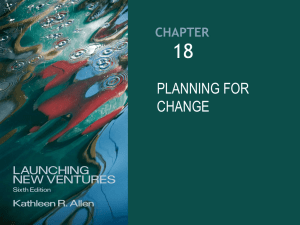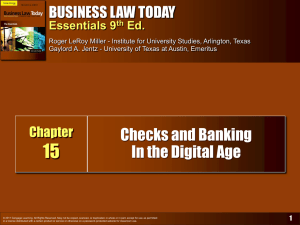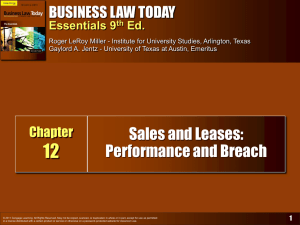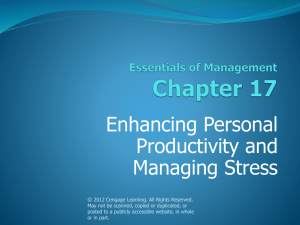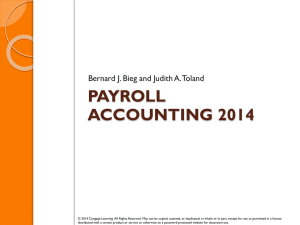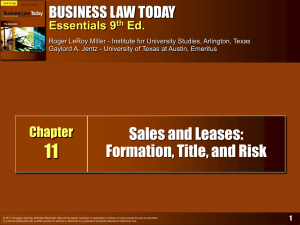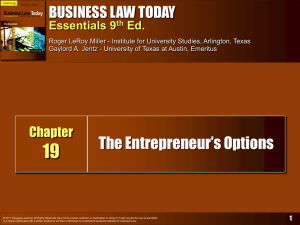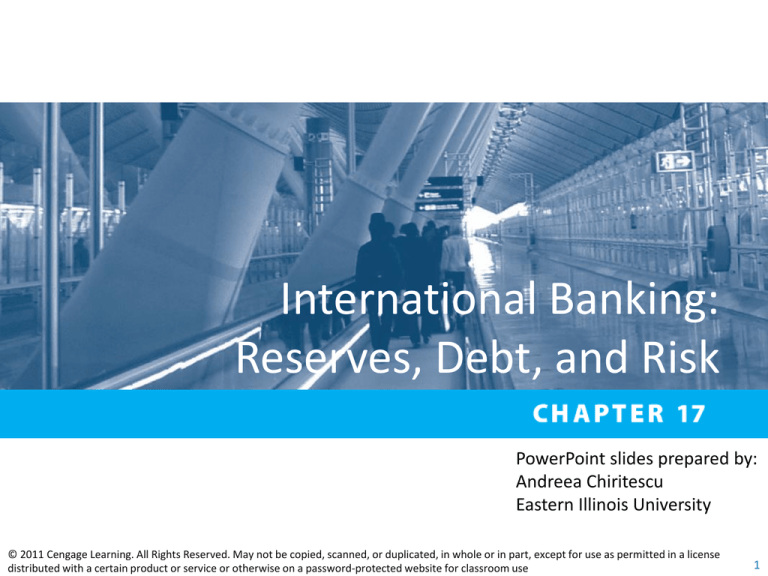
International Banking:
Reserves, Debt, and Risk
PowerPoint slides prepared by:
Andreea Chiritescu
Eastern Illinois University
© 2011 Cengage Learning. All Rights Reserved. May not be copied, scanned, or duplicated, in whole or in part, except for use as permitted in a license
distributed with a certain product or service or otherwise on a password‐protected website for classroom use
1
Nature of International Reserves
• International reserves
• Enable nations to finance disequilibrium in
their balance-of-payments positions
• Deficit: monetary receipts fall short of monetary
payments
• Settled with international reserves
• Enable nations to sustain temporary balanceof-payments deficits
• Until acceptable adjustment measures can operate
to correct the disequilibrium
© 2011 Cengage Learning. All Rights Reserved. May not be copied, scanned, or duplicated, in whole or in part, except for use as permitted in a license
distributed with a certain product or service or otherwise on a password‐protected website for classroom use
2
Demand for International Reserves
• Demand for international reserves
• Depends on
• Monetary value of international transactions
• Disequilibrium that can arise in balance-ofpayments positions
• Contingent on
• Speed and strength of the balance-of-payments
adjustment mechanism
• Overall institutional framework of the world
economy
© 2011 Cengage Learning. All Rights Reserved. May not be copied, scanned, or duplicated, in whole or in part, except for use as permitted in a license
distributed with a certain product or service or otherwise on a password‐protected website for classroom use
3
Demand for International Reserves
• Demand for international reserves
• Exchange-rate flexibility
• Automatic adjustment mechanisms that
respond to payments disequilibrium
• Economic policies used to bring about
payments equilibrium
• International coordination of economic policies
© 2011 Cengage Learning. All Rights Reserved. May not be copied, scanned, or duplicated, in whole or in part, except for use as permitted in a license
distributed with a certain product or service or otherwise on a password‐protected website for classroom use
4
Demand for International Reserves
• Changes in the degree of exchange-rate
flexibility
• Inversely related to changes in the quantity of
international reserves demanded
• More rapid and flexible exchange-rate
adjustments requires smaller reserves
© 2011 Cengage Learning. All Rights Reserved. May not be copied, scanned, or duplicated, in whole or in part, except for use as permitted in a license
distributed with a certain product or service or otherwise on a password‐protected website for classroom use
5
FIGURE 17.1 The demand for international reserves and
exchange-rate flexibility
When exchange rates are fixed (pegged) by monetary authorities, international reserves are necessary for
the financing of payment imbalances and the stabilization of exchange rates. With floating exchange
rates, payment imbalances tend to be corrected by market-induced fluctuations in the exchange rate; the
need for exchange-rate stabilization and international reserves then disappears.
© 2011 Cengage Learning. All Rights Reserved. May not be copied, scanned, or duplicated, in whole or in part, except for use as permitted in a license
distributed with a certain product or service or otherwise on a password‐protected website for classroom use
6
Demand for International Reserves
• Automatic adjustment mechanisms
• Prices, interest rates, incomes, and monetary
flows
• The more efficient each of these adjustment
mechanisms is
• The smaller and more short-lived market
imbalances will be and
• The fewer reserves will be needed
© 2011 Cengage Learning. All Rights Reserved. May not be copied, scanned, or duplicated, in whole or in part, except for use as permitted in a license
distributed with a certain product or service or otherwise on a password‐protected website for classroom use
7
Demand for International Reserves
• Choice & effectiveness of government policies
• Adopted to correct payments imbalances
• The greater a nation’s propensity to apply
commercial policies to key sectors
• Tariffs, quotas, and subsidies
• The less will be its need for international
reserves
• Assuming that the policies are effective in
reducing payments disequilibrium
© 2011 Cengage Learning. All Rights Reserved. May not be copied, scanned, or duplicated, in whole or in part, except for use as permitted in a license
distributed with a certain product or service or otherwise on a password‐protected website for classroom use
8
Demand for International Reserves
• International coordination of economic policies
• Goal of economic cooperation:
• Reduce the frequency and extent of payment
imbalances
• Reduce the demand for international reserves
• Quantity demanded of international reserves
• Positively related to the level of world prices
and income
© 2011 Cengage Learning. All Rights Reserved. May not be copied, scanned, or duplicated, in whole or in part, except for use as permitted in a license
distributed with a certain product or service or otherwise on a password‐protected website for classroom use
9
Supply of International Reserves
• Total supply of international reserves
• Owned reserves
• Gold, acceptable foreign currencies
• Special drawing rights (SDRs)
• Borrowed reserves
• Lenders:
• Foreign nations with excess reserves
• Foreign financial institutions
• International agencies
© 2011 Cengage Learning. All Rights Reserved. May not be copied, scanned, or duplicated, in whole or in part, except for use as permitted in a license
distributed with a certain product or service or otherwise on a password‐protected website for classroom use
10
Foreign Currencies
• 1800s–1900s, reserve currencies
• The U.S. dollar
• The UK pound
• Trading nations have traditionally been willing
to hold them as international reserve assets
• Since World War II, the U.S. dollar has been the
dominant reserve currency
© 2011 Cengage Learning. All Rights Reserved. May not be copied, scanned, or duplicated, in whole or in part, except for use as permitted in a license
distributed with a certain product or service or otherwise on a password‐protected website for classroom use
11
Foreign Currencies
• The U.S. dollar as reserve currency
• Early 1950s - a dollar-shortage era
• Massive development programs in Europe
• Excess demand for the dollars
• Late 1950s, dollar glut
• U.S. continued to provide reserves to the world
through its payments deficits
• 1960s, liquidity problem
• 1970, creation of SDRs as reserve assets
© 2011 Cengage Learning. All Rights Reserved. May not be copied, scanned, or duplicated, in whole or in part, except for use as permitted in a license
distributed with a certain product or service or otherwise on a password‐protected website for classroom use
12
TABLE 17.1 International reserves, 2006, all countries
(in billions of SDRs*)
© 2011 Cengage Learning. All Rights Reserved. May not be copied, scanned, or duplicated, in whole or in part, except for use as permitted in a license
distributed with a certain product or service or otherwise on a password‐protected website for classroom use
13
GLOBALIZATION
Should SDRs replace the dollar as
the world’s reserve currency?
• The United States dollar
• Main reserve currency in the world today
• Medium of exchange, unit of account, and store of
value
• Wealth in dollar-denominated assets
• 64% of world’s official foreign exchange reserves
• 86% of daily foreign exchange trades
• Other reserve currencies
• The euro, the British pound, Japanese yen
© 2011 Cengage Learning. All Rights Reserved. May not be copied, scanned, or duplicated, in whole or in part, except for use as permitted in a license
distributed with a certain product or service or otherwise on a password‐protected website for classroom use
14
GLOBALIZATION
Should SDRs replace the dollar as
the world’s reserve currency?
• Benefits for the U.S.
• Americans
• Can purchase products at a marginally cheaper rate
• Can borrow at lower interest rates for homes and
automobiles
• The U.S. government
• Can finance larger deficits longer and at lower
interest rates
• Can issue debt (securities) in its own currency
• Pushing exchange rate risk onto foreign lenders
© 2011 Cengage Learning. All Rights Reserved. May not be copied, scanned, or duplicated, in whole or in part, except for use as permitted in a license
distributed with a certain product or service or otherwise on a password‐protected website for classroom use
15
GLOBALIZATION
Should SDRs replace the dollar as
the world’s reserve currency?
• Concerns
• Substantial dollar depreciation
• Losing purchasing power
• The U.S. - huge deficits and massive borrowing
• Volatility of the dollar
• Destabilizing effect that it can have on international
trade and finance
© 2011 Cengage Learning. All Rights Reserved. May not be copied, scanned, or duplicated, in whole or in part, except for use as permitted in a license
distributed with a certain product or service or otherwise on a password‐protected website for classroom use
16
GLOBALIZATION
Should SDRs replace the dollar as
the world’s reserve currency?
• 2009, China - Special Drawing Right (SDR) to
replace the dollar
• New world reserve currency
• Based on a basket of currencies instead of just
the dollar
• SDR: euro, yen, pound, and dollar
• Expand to include all major currencies
• SDR would be managed by the IMF
© 2011 Cengage Learning. All Rights Reserved. May not be copied, scanned, or duplicated, in whole or in part, except for use as permitted in a license
distributed with a certain product or service or otherwise on a password‐protected website for classroom use
17
GLOBALIZATION
Should SDRs replace the dollar as
the world’s reserve currency?
• Benefits of SDRs
• China - cushion any depreciation in the dollar’s
exchange value
• Help stabilize the value of China’s holdings of U.S.
Treasury securities
• Support aggregate demand in the world
• Economic welfare of the world should not
depend on the behavior of a single currency
© 2011 Cengage Learning. All Rights Reserved. May not be copied, scanned, or duplicated, in whole or in part, except for use as permitted in a license
distributed with a certain product or service or otherwise on a password‐protected website for classroom use
18
GLOBALIZATION
Should SDRs replace the dollar as
the world’s reserve currency?
• Benefits of SDRs
• Currency risk - diversified through a basket
reserve unit
• Enhancing stability and confidence throughout the
world
• Equity
• U.S. can attract the savings of other countries even
when the interest rates it pays are very low
© 2011 Cengage Learning. All Rights Reserved. May not be copied, scanned, or duplicated, in whole or in part, except for use as permitted in a license
distributed with a certain product or service or otherwise on a password‐protected website for classroom use
19
GLOBALIZATION
Should SDRs replace the dollar as
the world’s reserve currency?
• Potential pitfalls of SDRs
• SDR is backed by nothing other than the good
faith and credit of the IMF
• Who would determine the “right price” of the
SDR?
• Add another step to each international
transaction
• Convert local currency into SDRs
© 2011 Cengage Learning. All Rights Reserved. May not be copied, scanned, or duplicated, in whole or in part, except for use as permitted in a license
distributed with a certain product or service or otherwise on a password‐protected website for classroom use
20
GLOBALIZATION
Should SDRs replace the dollar as
the world’s reserve currency?
• The U.S. and SDRs
• Americans would have to pay more for
imported goods
• Interest rates on both private and
governmental debt would increase
• Increased private cost of borrowing
• Weaker consumption, decreased investment, and
slower growth
© 2011 Cengage Learning. All Rights Reserved. May not be copied, scanned, or duplicated, in whole or in part, except for use as permitted in a license
distributed with a certain product or service or otherwise on a password‐protected website for classroom use
21
Gold
• Gold standard, historically
•
•
•
•
International means of payments
Unit of account
Viable store of value
Overall acceptability
• Monetary role of gold today
• Glittering ghost haunting efforts to reform the
international monetary system
© 2011 Cengage Learning. All Rights Reserved. May not be copied, scanned, or duplicated, in whole or in part, except for use as permitted in a license
distributed with a certain product or service or otherwise on a password‐protected website for classroom use
22
Gold
• International gold standard, 1880 to 1914
• Values of most national currencies were
anchored in gold
• Gold coins circulated
• Generally accepted means of payment
• Money supply
• Fixed relation to the monetary stock of gold
• Growth in monetary gold
• Growth in the money supply
• At a rate that corresponded to the growth in real
national output
© 2011 Cengage Learning. All Rights Reserved. May not be copied, scanned, or duplicated, in whole or in part, except for use as permitted in a license
distributed with a certain product or service or otherwise on a password‐protected website for classroom use
23
Gold
• U.S. and the gold standard
• 1934, the Gold Reserve Act
• U.S. government - title to all monetary gold
• Required citizens to turn in their private holdings to
the U.S. Treasury
• The U.S. dollar - devalued in 1934
• Official price of gold was raised from $20.67 to $35
per ounce
© 2011 Cengage Learning. All Rights Reserved. May not be copied, scanned, or duplicated, in whole or in part, except for use as permitted in a license
distributed with a certain product or service or otherwise on a password‐protected website for classroom use
24
Gold
• Gold exchange standard, dollar-gold system
• International monetary system as formulated
by the IMF nations
• To economize on monetary gold stocks as
international reserves
• The U.S – dominant economy
• Productive capacity and national wealth
© 2011 Cengage Learning. All Rights Reserved. May not be copied, scanned, or duplicated, in whole or in part, except for use as permitted in a license
distributed with a certain product or service or otherwise on a password‐protected website for classroom use
25
Gold
• Gold exchange standard, dollar-gold system
• The United States
• Assume the role of world banker
• The dollar - chief reserve currency of the
international monetary system
• Responsibility for buying and selling gold at a fixed
price to foreign official holders of dollars
• The dollar – convertible to gold
• All other currencies – pegged to the dollar
© 2011 Cengage Learning. All Rights Reserved. May not be copied, scanned, or duplicated, in whole or in part, except for use as permitted in a license
distributed with a certain product or service or otherwise on a password‐protected website for classroom use
26
Gold
• Gold exchange standard, dollar-gold system
• 1968, two-tier gold system
• Official tier - central banks could buy and sell gold
for monetary purposes at the official price of $35
per ounce
• Private market - gold as a commodity could be
traded at the free-market price
© 2011 Cengage Learning. All Rights Reserved. May not be copied, scanned, or duplicated, in whole or in part, except for use as permitted in a license
distributed with a certain product or service or otherwise on a password‐protected website for classroom use
27
Gold
• Demonetization of gold
• August 1971, President Richard Nixon
• The United States was suspending its commitment
to buy and sell gold at $35 per ounce
• U.S. stock of monetary had declined to $11 billion
• Deteriorating U.S. balance-of-payments position
• January 1, 1975
• The official price of gold was abolished as the unit
of account for the international monetary system
© 2011 Cengage Learning. All Rights Reserved. May not be copied, scanned, or duplicated, in whole or in part, except for use as permitted in a license
distributed with a certain product or service or otherwise on a password‐protected website for classroom use
28
Special Drawing Rights
• SDR
• Created in 1970 by the IMF
• A new reserve asset
• Objective: to introduce into the payments
mechanism a new type of international money
• In addition to the dollar and gold
© 2011 Cengage Learning. All Rights Reserved. May not be copied, scanned, or duplicated, in whole or in part, except for use as permitted in a license
distributed with a certain product or service or otherwise on a password‐protected website for classroom use
29
Special Drawing Rights
• SDR today
• Limited use as a reserve asset
• Main function: unit of account of the IMF and
some other international organizations
• Some of the IMF’s member nations peg their
currency values to the SDR
• Potential claim on the freely usable currencies
of IMF members
© 2011 Cengage Learning. All Rights Reserved. May not be copied, scanned, or duplicated, in whole or in part, except for use as permitted in a license
distributed with a certain product or service or otherwise on a password‐protected website for classroom use
30
Special Drawing Rights
• Value of SDR
• Basket of currencies
• The U.S. dollar, Japanese yen, UK pound, and the
euro
• The weights of the currencies reflect the
amount of exports and imports of these
countries during the previous five years
© 2011 Cengage Learning. All Rights Reserved. May not be copied, scanned, or duplicated, in whole or in part, except for use as permitted in a license
distributed with a certain product or service or otherwise on a password‐protected website for classroom use
31
Facilities for Borrowing Reserves
• IMF drawings
• The transactions by which the fund makes
foreign-currency loans available
• Deficit nations
• Do not borrow from the fund
• Purchase with their own currency the foreign
currency required to help finance deficits
• Reverse the transaction when the balance-ofpayments position improves
© 2011 Cengage Learning. All Rights Reserved. May not be copied, scanned, or duplicated, in whole or in part, except for use as permitted in a license
distributed with a certain product or service or otherwise on a password‐protected website for classroom use
32
Facilities for Borrowing Reserves
• General Arrangements to Borrow, 1962
• G-10 agreed to lend the fund up to a maximum
of $6 billion
• Do not provide a permanent increase in the
supply of world reserves
• Once the loans are repaid, world reserves revert
back to their original levels
• World reserves - more flexible and adaptable to
the needs of deficit nations
© 2011 Cengage Learning. All Rights Reserved. May not be copied, scanned, or duplicated, in whole or in part, except for use as permitted in a license
distributed with a certain product or service or otherwise on a password‐protected website for classroom use
33
Facilities for Borrowing Reserves
• Swap arrangements
• Bilateral agreements between central banks
• Each government provides for an exchange of
currencies to help finance temporary payments
disequilibrium
• The nation requesting the swap
• Expected to use the funds to help ease its
payments deficits and discourage speculative
capital outflows
• Repay within a stipulated period of time, normally
within 3 to 12 months
© 2011 Cengage Learning. All Rights Reserved. May not be copied, scanned, or duplicated, in whole or in part, except for use as permitted in a license
distributed with a certain product or service or otherwise on a password‐protected website for classroom use
34
International Lending Risk
• Credit risk
• Financial
• The probability that part or all of the interest or
principal of a loan will not be repaid
• The larger the potential for default on a loan
• The higher the interest rate that the bank must
charge the borrower
© 2011 Cengage Learning. All Rights Reserved. May not be copied, scanned, or duplicated, in whole or in part, except for use as permitted in a license
distributed with a certain product or service or otherwise on a password‐protected website for classroom use
35
International Lending Risk
• Country risk - Political
• Closely related to political developments in a
country
• Government’s views concerning international
investments and loans
• Currency risk - Economic
• Associated with currency depreciations and
appreciations as well as exchange controls
© 2011 Cengage Learning. All Rights Reserved. May not be copied, scanned, or duplicated, in whole or in part, except for use as permitted in a license
distributed with a certain product or service or otherwise on a password‐protected website for classroom use
36
The Problem of International Debt
• Concern: insufficient international lending
• After the oil shocks in 1974–1975 and 1979–
1980
• Oil-importing developing nations might not be able
to obtain loans to finance trade deficits
• Resulting from the huge increases in the price of oil
• Able to borrow dollars from commercial banks
• 1980s, commercial banks
• Part of an international debt problem
• Lent so much to developing nations
© 2011 Cengage Learning. All Rights Reserved. May not be copied, scanned, or duplicated, in whole or in part, except for use as permitted in a license
distributed with a certain product or service or otherwise on a password‐protected website for classroom use
37
The Problem of International Debt
• Debt service/export ratio
• Indicator of debt burden
• Scheduled interest and principal payments as a
percentage of export earnings
• Interest rate that the nation pays on its external
debt
• Growth in its exports of goods and services
© 2011 Cengage Learning. All Rights Reserved. May not be copied, scanned, or duplicated, in whole or in part, except for use as permitted in a license
distributed with a certain product or service or otherwise on a password‐protected website for classroom use
38
The Problem of International Debt
• A nation has debt-servicing problems because
• May have pursued improper macroeconomic
policies that contribute to large balance-ofpayments deficits
• May have borrowed excessively or on
unfavorable terms
• May have been affected by adverse economic
events that it could not control
© 2011 Cengage Learning. All Rights Reserved. May not be copied, scanned, or duplicated, in whole or in part, except for use as permitted in a license
distributed with a certain product or service or otherwise on a password‐protected website for classroom use
39
The Problem of International Debt
• Options for a nation facing debt-servicing
difficulties
•
•
•
•
Cease repayments on its debt
Service its debt at all costs
Debt rescheduling
Obtain emergency loans from the IMF
• Conditionality
© 2011 Cengage Learning. All Rights Reserved. May not be copied, scanned, or duplicated, in whole or in part, except for use as permitted in a license
distributed with a certain product or service or otherwise on a password‐protected website for classroom use
40
Reducing Bank Exposure to DevelopingNation Debt
• Stability of the international financial system
• Threatened when developing nations cannot
meet their debt obligations to foreign banks
• Banks - improve their financial position
• Increasing their capital base
• Setting aside reserves to cover losses
• Reducing new loans to debtor nations
© 2011 Cengage Learning. All Rights Reserved. May not be copied, scanned, or duplicated, in whole or in part, except for use as permitted in a license
distributed with a certain product or service or otherwise on a password‐protected website for classroom use
41
Reducing Bank Exposure to DevelopingNation Debt
• Banks - improve their financial position
• Liquidate developing-nation debt
• Loan sales to other banks in the secondary market
• Debt buyback
• Government of the debtor nation buys the loans
from the commercial bank at a discount
• Debt-for-debt swaps
• Bank exchanges its loans for securities issued by
the debtor nation’s government
• Lower interest rate or discount
© 2011 Cengage Learning. All Rights Reserved. May not be copied, scanned, or duplicated, in whole or in part, except for use as permitted in a license
distributed with a certain product or service or otherwise on a password‐protected website for classroom use
42
Reducing Bank Exposure to DevelopingNation Debt
• Banks - improve their financial position
• Debt/equity swaps
• Commercial bank sells its loans at a discount to the
developing-nation government
• For local currency, which it then uses to finance an
equity investment in the debtor nation
• Debt reduction
• Debt forgiveness
© 2011 Cengage Learning. All Rights Reserved. May not be copied, scanned, or duplicated, in whole or in part, except for use as permitted in a license
distributed with a certain product or service or otherwise on a password‐protected website for classroom use
43
Debt Reduction and Debt Forgiveness
• Debt reduction
• Voluntary scheme that lessens the burden on
the debtor nation to service its external debt
• Use of negotiated modifications in the terms and
conditions of the contracted debt
• Debt reschedulings
• Retiming of interest payments
• Improved borrowing terms
• Debt/equity swaps
• Debt buybacks
© 2011 Cengage Learning. All Rights Reserved. May not be copied, scanned, or duplicated, in whole or in part, except for use as permitted in a license
distributed with a certain product or service or otherwise on a password‐protected website for classroom use
44
Debt Reduction and Debt Forgiveness
• Debt forgiveness
• Arrangement that reduces the value of
contractual obligations of the debtor nation
• Markdowns of developing-nation debt
• Write-offs of developing-nation debt
• Abrogation of existing obligations to pay interest
© 2011 Cengage Learning. All Rights Reserved. May not be copied, scanned, or duplicated, in whole or in part, except for use as permitted in a license
distributed with a certain product or service or otherwise on a password‐protected website for classroom use
45
The Eurodollar Market
• Eurodollar market
• Eurocurrency market
• Financial intermediary
• Brings together lenders and borrowers
• Bank deposit liabilities
• Time deposits
• Denominated in U.S. dollars and other foreign
currencies in banks outside the United States
• Transactions in dollars
• Three-fourths of the volume of transactions
© 2011 Cengage Learning. All Rights Reserved. May not be copied, scanned, or duplicated, in whole or in part, except for use as permitted in a license
distributed with a certain product or service or otherwise on a password‐protected website for classroom use
46
The Eurodollar Market
• Eurodollar market
• Eurodollar deposits
• Redeposited in other foreign banks, lent to
business enterprises, invested, or retained to
improve reserves or overall liquidity
• Free of regulation by the host country
• Eurodollars increase the efficiency of
international trade and finance
• Internationally accepted medium of exchange,
store of value, standard of value
© 2011 Cengage Learning. All Rights Reserved. May not be copied, scanned, or duplicated, in whole or in part, except for use as permitted in a license
distributed with a certain product or service or otherwise on a password‐protected website for classroom use
47

